Did you know range balls can travel up to 30 yards less than premium golf balls? This fact shows a big difference between driving range practice and playing on a full course. Golf fans often wonder if practicing at the driving range or playing on a full course is better. Each choice has its own benefits for improving your golf skills.
The driving range is a controlled place for focused practice. It lets you work on your swing without the stress of a full game. Golf courses, on the other hand, offer a full golfing experience. They challenge you to use your skills in real game situations. Knowing these differences is critical to improving your golf game.
Whether you’re new to golf or trying to get better, both driving ranges and golf courses are important. Let’s look at what each place offers and how they help you get better at golf.
Key Takeaways
- Driving ranges offer focused practice opportunities for specific skills
- Golf courses provide a complete playing experience and real-game scenarios
- Range balls perform differently from premium golf balls, affecting distance and spin
- A combination of driving range and course play is ideal for overall improvement
- Practice strategies should align with individual goals for noticeable progress
- Regular practice sessions and rounds of golf are recommended for skill development
Table of Contents
- 1 Understanding Driving Ranges
- 2 Exploring Golf Courses
- 3 Driving Range vs Golf Course: Time commitment
- 4 Driving Range vs Golf Course: Cost comparison
- 5 Driving Range vs Golf Course: Skill development
- 6 Driving Range vs Golf Course: Social aspects
- 7 Driving Range vs Golf Course: Physical demands
- 8 Driving Range vs Golf Course: Pressure and mental game
- 9 When to Choose the Driving Range
- 10 When to Opt for the Golf Course
- 11 Combining Driving Range and Golf Course Practice
- 12 Technology in Driving Ranges vs Golf Courses
- 13 Environmental Considerations
- 14 Is practicing at a driving range as effective as playing on a golf course?
- 15 Can I improve my golf game by only using the driving range?
- 16 What skills can I develop at a driving range that I can’t on a golf course?
- 17 Are driving ranges more cost-effective than golf courses for practice?
Understanding Driving Ranges

Driving ranges are important spots for golfers of every level. They offer a place to sharpen your skills and boost your game.
What is a driving range?
A driving range is a special area for golfers to practice their swing and technique. It’s a place where you can focus on your game without the stress of a full course.
Purpose and benefits of using a driving range
Driving ranges have many uses for golfers. They are easy to get to and offer quick practice sessions. For amateur golfers, spending 30-40 minutes a few times a week is more practical than playing many rounds.
Common features of driving ranges
Driving range facilities have several key features to improve your practice:
- Hitting bays with practice mats
- Target greens at various distances
- Ball dispensers
- Club rentals
- Professional instruction services
| Feature | Description | Benefit |
|---|---|---|
| Practice mats | Durable surfaces for repetitive swings | Consistent lie for each shot |
| Target greens | Marked areas at different distances | Improves accuracy and distance control |
| Ball dispensers | Automated machines providing golf balls | Convenient access to practice balls |
Using these features, you can set up a practice routine that targets specific areas of your game. This approach is both effective and budget-friendly.
Exploring Golf Courses

Golf courses are special places for playing golf. They have different challenges and landscapes. Each hole in a typical 18-hole course is unique, offering its own set of obstacles and chances.
What is a Golf Course?
A golf course is a carefully made landscape for playing golf. It’s where you use your skills learned at the driving range. Courses vary, fitting different skill levels and schedules.
Purpose and Benefits of Playing on a Golf Course
Playing on a golf course helps improve your game strategy and management. It lets you face all kinds of challenges, from long drives to precise putting. Courses also offer a chance to meet others, hosting events and tournaments.
Common Features of Golf Courses
Golf courses have several key features:
- Fairways: Long, narrow stretches of short grass leading to the green
- Greens: Closely mowed areas surrounding the hole
- Bunkers: Sand-filled hazards testing your short game
- Water hazards: Lakes, ponds, or streams adding challenge to shots
- Tee boxes: Starting points for each hole
Golf courses differ in how easy they are to get to and how much they cost. Municipal courses are affordable and open to all. Executive courses, with shorter holes, are great for those short on time.
| Course Type | Green Fees (USD) | Tee Times |
|---|---|---|
| Municipal | 30-50 | Flexible, often first-come-first-serve |
| Executive | 20-40 | Easier to book, shorter wait times |
| Private | 100+ | Members-only, advance booking required |
Remember, what you wear to play golf matters. Professional tournaments have strict dress codes. Before playing on a course, consider taking lessons to improve your game and etiquette.
Driving Range vs Golf Course: Time commitment

Golf lovers understand the importance of managing their time. The time spent at a driving range is different from playing a full round. At a driving range, you can adjust your practice to fit your schedule. You can spend anywhere from 30 minutes to several hours improving your game.
However, playing a full round of golf takes more time. The United States Golf Association (USGA) says a typical game lasts about four to four and a half hours. This longer time allows for a full golfing experience but requires careful planning of your day.
| Location | Average Time Commitment | Flexibility |
|---|---|---|
| Driving Range | 30 minutes – 2 hours | High |
| Golf Course (18 holes) | 4 – 4.5 hours | Low |
Driving ranges are great for those with tight schedules. You can quickly fit in a practice session during your lunch break or after work. Golf courses, while offering a complete experience, need more planning. They often have limited tee times, especially during busy hours.
Choosing between a driving range and a golf course depends on your schedule and goals. Driving ranges are perfect for focused, short practice sessions. Golf courses, on the other hand, provide a full-game experience that tests your skills in a real setting.
Driving Range vs Golf Course: Cost comparison
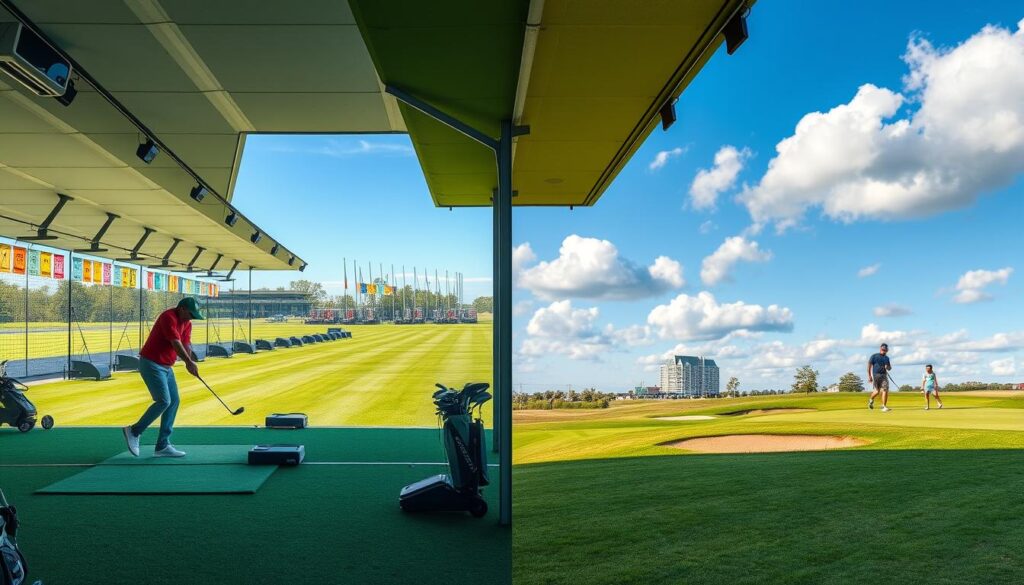
Cost is a big deal when it comes to golf practice. Driving ranges are a cheaper way to practice often. A bucket of balls costs between $6 and $13, depending on size. At Santa Barbara Golf Club, you can get a small bucket for $6, a medium for $10, or a large for $13.
Golf courses, however, offer a full experience but cost more. Green fees are higher than driving range prices. Plus, renting equipment adds to the cost. At Santa Barbara Golf Club, Titleist Rental Clubs are $40 for 18 holes or $20 for 9 holes.
Membership fees can help save money for those who play often. Some golfers use affordable golf rangefinders to improve their game without spending a lot. Here’s a cost comparison:
| Facility | Cost | What’s Included |
|---|---|---|
| Driving Range | $6 – $13 | 35 – 105 balls |
| Golf Course | $40 – $200+ | 18-hole play, may include cart |
| Equipment Rental | $20 – $40 | Club set for 9 or 18 holes |
Driving ranges are cheaper for practice, but golf courses offer a full experience. Your choice depends on your goals, budget, and how much time you have.
Driving Range vs Golf Course: Skill development

Driving ranges and golf courses are great for improving your golf skills. At the range, you can work on your swing and aim. You might hit 50 to 70 shots in an hour, getting better with each try.
Golf courses, however, offer a bigger challenge. In an 18-hole round, you’ll hit fewer shots but each one matters. This setting helps you learn to manage the course and handle pressure.
- Blocked practice at the range for fundamental swing mechanics
- Skills games at the range to improve shot accuracy
- Multiple balls on the course for situational practice
- Competitive play to enhance overall golf techniques
Using both the range and the course in your training is important for hitting more accurate shots. It helps you practice a lot and then apply what you’ve learned on the course. This way, you’ll get better at golf and enjoy playing more.
Driving Range vs Golf Course: Social aspects

Golf courses offer a unique social experience that driving ranges can’t match. On a course, you’ll find yourself immersed in the golfing community. You’ll engage in social interactions that go beyond mere practice.
The leisurely pace of play allows for networking opportunities. You can have casual conversations with fellow golfers. Golf etiquette plays a crucial role in these social dynamics.
Learning and practicing proper behavior on the course helps you integrate smoothly into the golfing community. This social aspect is particularly appealing to many players, as evidenced by recent statistics:
- 75% of driving range golfers don’t transition to course play
- Courses offering beginner-friendly events see a 30% increase in range-to-course transitions
- Community-building activities lead to a 25% higher retention rate of course players
Some golf facilities are revolutionizing the social experience. For example, Arrowood Golf Course in Oceanside, California, added Toptracer Range technology with a new lounge. This setup provides a social setting complete with comfortable seating, TVs, heaters, and food services.
| Aspect | Driving Range | Golf Course |
|---|---|---|
| Social Interaction | Limited | Extensive |
| Networking Opportunities | Few | Many |
| Community Building | Minimal | Significant |
| Golf Etiquette Practice | Not applicable | Essential |
While driving ranges focus on individual practice, golf courses foster a sense of community. This social aspect often proves to be a significant factor in attracting and retaining players. It makes the golf course experience uniquely rewarding for many enthusiasts.
Driving Range vs Golf Course: Physical demands

Golf courses offer a more comprehensive workout than driving ranges. Playing a full round means walking several miles. You might carry or pull your golf bag, which boosts your fitness and endurance.
Driving ranges, however, require less effort. You stay in one spot, focusing on your swing. This helps your technique but doesn’t match the physical conditioning of a course.
| Physical Aspect | Driving Range | Golf Course |
|---|---|---|
| Walking distance | Minimal | 2-5 miles per round |
| Duration | 1 hour average | 4-5 hours per round |
| Terrain variety | Limited | Diverse (hills, bunkers, rough) |
A round of golf demands adaptability to various terrains. You’ll face uphill lies, navigate through bunkers, and trudge through rough. This diverse physical challenge is something a driving range can’t replicate.
While both settings have their merits, golf courses are better for physical demands. They push your body in ways that boost your golf-specific fitness. This prepares you for competitive play.
Driving Range vs Golf Course: Pressure and mental game
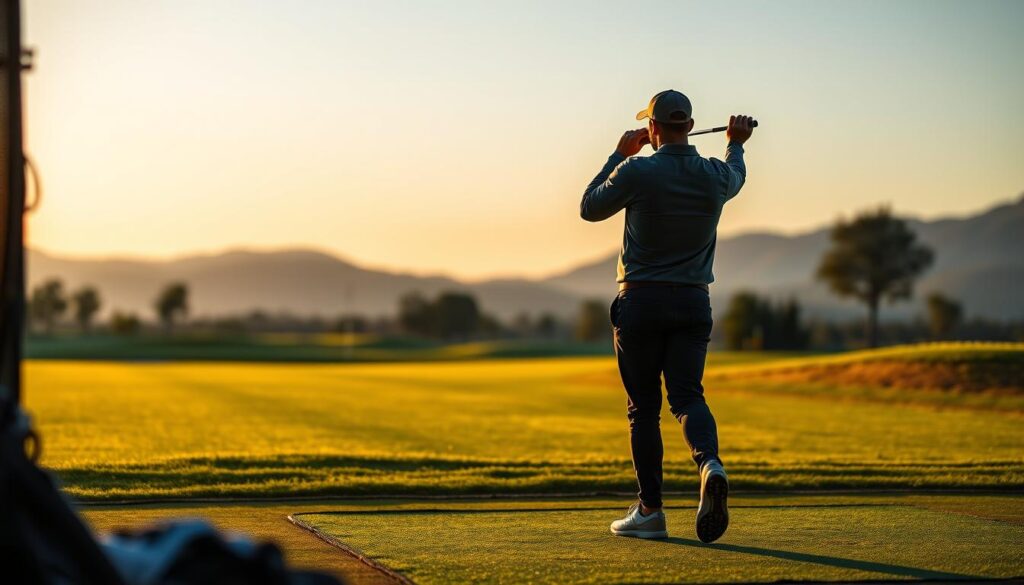
The driving range and golf course are different places for improving your mental game. At the range, you can practice without the stress of a real game. This calm setting helps you focus on improving your technique.
Golf courses, however, bring real challenges that test your mental strength. You face various conditions, make quick decisions, and deal with the results of each shot. This environment is vital for learning to perform well under pressure.
Golf psychology is important in moving from range to course performance. Many golfers find it hard to use their skills in real games. The change in mindset when you step onto the first tee can greatly affect your game.
| Mental Aspect | Driving Range | Golf Course |
|---|---|---|
| Pressure | Low | High |
| Focus | Technique-oriented | Result-oriented |
| Decision Making | Limited | Constant |
| Distractions | Minimal | Numerous |
To get better at your mental game, try these tips:
- Practice with purpose, varying shots and targets on the range
- Take short breaks between shots to simulate on-course rhythm
- Use your full pre-shot routine during practice
- Create challenging scenarios at the range to mimic course conditions
- Keep a performance journal to track progress and identify areas for improvement
By working on these areas, you’ll build the mental toughness needed to perform well under pressure, both at the range and on the course.
When to Choose the Driving Range

Driving ranges are great for golfers at all levels. They’re perfect for practicing golf basics or focusing on specific skills. This makes them ideal for both beginners and seasoned players.
Learning the Basics
For new golfers, driving ranges are the best place to start. They offer a relaxed environment to learn the basics. You can work on your grip, stance, and swing without the stress of a full course.
Stats show that most golfers at ranges aim for the 150-yard white stake. This makes it easier to see how you’re improving.
Focused Skill Development
Driving ranges are great for targeted practice. You can focus on improving your drive or iron play. This focused practice helps build muscle memory and improve your skills.
Time-Efficient Training
If you’re short on time, driving ranges are perfect. You can fit in a quick session, hitting 50-100 balls. This quick practice can still help you improve your game.
Off-Season Practice
Driving ranges are also great for practicing during the winter. Many have covered or heated bays. This lets you keep your swing sharp all year long.
| Practice Type | Recommended Balls | Time (minutes) |
|---|---|---|
| Warm-up | 5-10 wedge shots | 10-15 |
| Full session | 50-100 mixed clubs | 30-60 |
| Quick tune-up | 25-30 focused shots | 15-20 |
When to Opt for the Golf Course
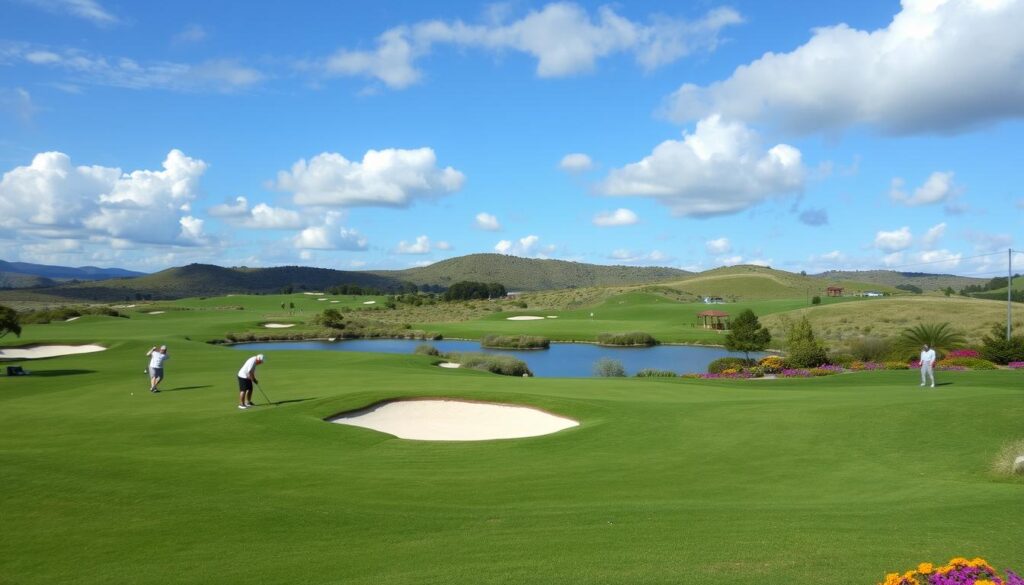
Playing on a golf course has its own set of benefits. It’s different from the driving range. You get to apply your skills in real game conditions, which is critical for improvement.
Apply Skills in Real Game Settings
Golf courses test your skills with different terrains and clubs. Unlike the range, where 62% of golfers stick to one club, the course forces you to switch. This improves your game.
Complete Golfing Experience
A round of golf is more than just hitting balls. It’s about navigating the course, making strategic decisions, and handling different lies. This full experience is crucial for mastering the game.
Improve Course Management Skills
Playing on a golf course sharpens your course management skills. You learn to read greens, plan shots, and make smart decisions. These skills are vital for better scores and becoming a skilled golfer.
Tournament Preparation
For those preparing for tournaments, playing on a course is essential. It prepares you for the pressure and helps refine your mental game. Research shows that 45% of golfers struggle with swing flaws under pressure, making on-course practice critical.
| Golf Course | Green Fees (Weekday) | Green Fees (Weekend) | Tee Times |
|---|---|---|---|
| Pebble Beach Golf Links | $575 | $575 | 7:00 AM – 5:00 PM |
| Augusta National Golf Club | $525 (members only) | $525 (members only) | 8:00 AM – 4:00 PM |
| TPC Sawgrass | $450 | $600 | 7:30 AM – 6:00 PM |
Combining Driving Range and Golf Course Practice
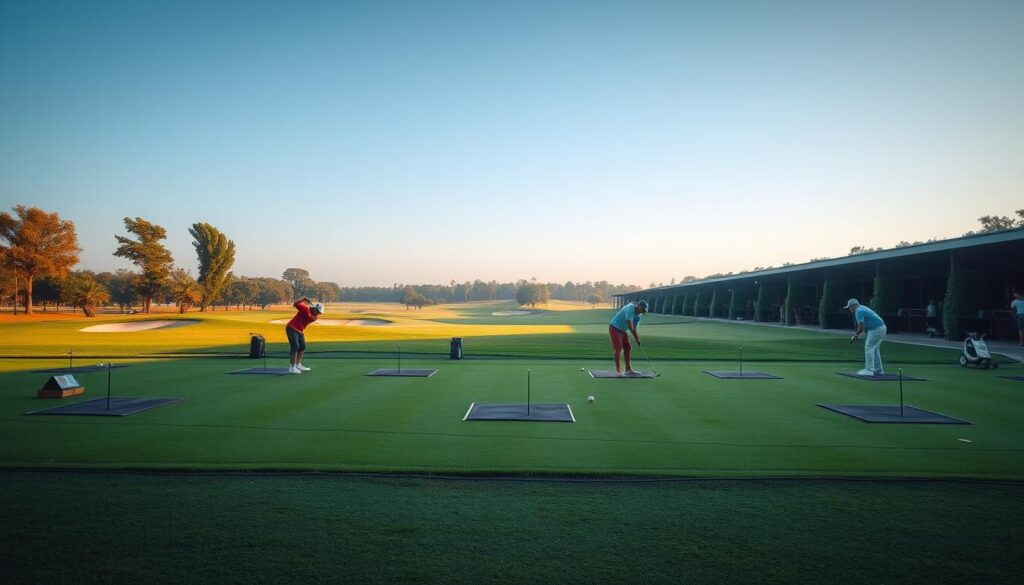
A good golf practice plan mixes driving range sessions with playing on the course. This way, you get better at transferring skills and improving your game.
Creating a Balanced Practice Routine
For a solid practice plan, include both range and course time. Begin with a structured range session:
- Warm-up (10 balls)
- Technical practice (20 balls)
- Skills games (20 balls)
- Pressure practice (10 balls)
Use alignment aids and focus on core shots for better practice. Plan your sessions to target weaknesses for real progress.
Transitioning Skills from Range to Course
To improve skill transfer, mix block and random practice. Block practice sharpens your technique, while random practice gets you ready for the course. Spend 15-20 minutes hitting shots without a target using a 7- or 8-iron for technical work.
Using Driving Range to Supplement Course Play
After a round, go to the range to work on weak areas. Focus on wedge shots to build confidence and find your rhythm. Remember, consistent practice over 4-6 weeks is crucial for real improvement in your golf game.
| Practice Area | Focus | Benefits |
|---|---|---|
| Driving Range | Technical skills, repetition | Improve swing mechanics, muscle memory |
| Golf Course | Strategy, course management | Real-game scenarios, mental game |
| Combined Approach | Skill transfer, game improvement | Comprehensive development, better performance |
Technology in Driving Ranges vs Golf Courses

Golf tech innovations are changing both driving ranges and golf courses. The gap between practicing and playing is getting smaller. This is thanks to advanced tools for tracking performance and analyzing golf data.
Driving Range Innovations
Modern driving ranges now have launch monitors and virtual golf simulators. These tools give you instant feedback on your swing and ball speed. Trackman and Toptracer have changed over 1,500 ranges worldwide, with Toptracer reaching 1,000 sites and 37,500 bays by 2023.
Golf Course Technology
On the course, GPS systems and mobile apps improve your game. They give you precise yardages and digital scorekeeping. This helps you make better decisions and manage your game better.
Bridging the Gap
Technology is making both environments more connected. Data from your range sessions can help your on-course strategy. This consistency in data analysis makes your practice more effective and your play better.
| Technology | Driving Range | Golf Course |
|---|---|---|
| Shot Tracking | Launch monitors, simulators | GPS-enabled clubs, mobile apps |
| Performance Analysis | Instant feedback, data visualization | Post-round statistics, shot dispersion |
| User Experience | Virtual games, target practice | Digital scorecards, course mapping |
Only 5% of North American ranges use tracking technology now. But there’s a lot of room for growth. As these innovations spread, your practice will get better and your game will improve a lot.
Environmental Considerations

Golf facilities face unique environmental challenges. Both driving ranges and golf courses are adopting eco-friendly golf practices. This shift towards sustainable golf management is crucial for the sport’s future.
Driving Range Sustainability Efforts
Driving ranges are implementing innovative sustainability measures. Many now use recycled balls and energy-efficient lighting. These simple changes contribute significantly to environmental conservation efforts.
Golf Course Environmental Impact and Management
Golf courses deal with broader environmental issues. Water conservation is a top priority, with courses in arid regions like Utah using up to 9 million gallons daily. To address this, many are adopting drought-resistant grass and efficient irrigation systems.
Wildlife preservation is another focus area. The Audubon Cooperative Sanctuary Program helps golf courses protect ecosystems. It creates habitats for endangered species like monarch butterflies. This initiative supports biodiversity while enhancing the golfing experience.
| Environmental Concern | Sustainable Solution |
|---|---|
| Water Usage | Drought-resistant grass, recycled water irrigation |
| Chemical Use | Eco-friendly fertilizers and pesticides |
| Energy Consumption | Solar power, energy-efficient equipment |
| Habitat Loss | Native vegetation preservation, wildlife corridors |
By embracing these sustainable practices, golf facilities are not only preserving the environment. They are also ensuring the long-term viability of the sport. As golfers, supporting these initiatives can make a significant difference in promoting eco-friendly golf.
Is practicing at a driving range as effective as playing on a golf course?
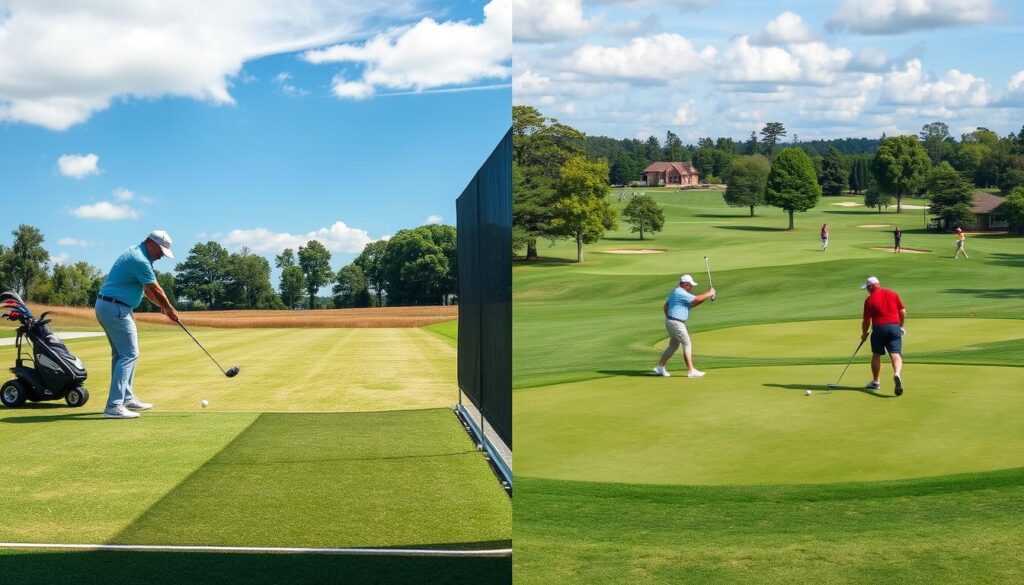
Golfers often debate whether driving ranges or golf courses are better for practice. Both have their own strengths, but they serve different purposes. They help in different ways to improve your game.
Driving ranges are great for fine-tuning your technique. You can hit many shots with the same club, focusing on one part of your swing at a time. This repetition helps build muscle memory, which is vital to improving your game.
Golf courses, however, offer a more realistic setting for practice. You face different lies, hazards, and weather conditions, unlike on the range. This variety helps you learn to adapt and make smart decisions, which are essential for effective practice.
| Aspect | Driving Range | Golf Course |
|---|---|---|
| Shot Volume | High (100+ shots per hour) | Low (32-34 shots in 4 hours) |
| Environment | Controlled, repetitive | Variable, realistic |
| Cost | Lower ($10 per bucket) | Higher (Greens fees vary) |
| Time Commitment | Flexible (30-60 minutes) | Fixed (4+ hours) |
To get the most out of your practice, mix both range and course work. Use the range for technique and the course for real-world application. This mix will boost your skills faster and make your practice more effective.
Can I improve my golf game by only using the driving range?

Using the driving range can help your golf game, but it has its limits. You can work on your swing and hitting the ball well. Yet, to fully develop your skills, you need more than just the range.
The range lacks real-world elements like different terrains and weather. It also doesn’t have the pressure of playing on a real course.
Practicing only at the driving range can make your swing better. But it won’t give you a complete golf game. You’ll miss out on important skills like:
- Course management
- Reading greens
- Dealing with different lies
- Handling real game pressure
To really get better, mix range practice with playing on actual courses. This way, you get a well-rounded game. Using a budget-friendly golf rangefinder can help bridge the gap between range and course.
Quality is more important than quantity in golf practice. Set specific goals and follow structured routines at the range. Then, use these skills on the course. This balanced approach will lead to real improvement and better performance when it matters most.
What skills can I develop at a driving range that I can’t on a golf course?

Driving ranges are great for improving your golf skills. They offer a chance to practice specific skills in a focused way. This is something you can’t do on a golf course.
At the driving range, you can work on your swing without the stress of scoring. This place is perfect for refining your technique. You can repeat shots to get better.
The range is ideal for improving your technique. You can try out different shots and clubs. Plus, you can work on your stance without worrying about hazards or other players.
| Skill | Driving Range Advantage | Impact on Performance |
|---|---|---|
| Grip Correction | Focused repetition | 70% improvement in shot consistency |
| Driver Stance | Isolated practice | 60% boost in overall performance |
| Ball Position | Immediate feedback | 50% increase in shot accuracy |
| Intentional Practice | Purpose-driven shots | 40% enhancement in skill progression |
Remember, understanding launch angles is important to improving at the driving range. By focusing on these skills, you’ll see big improvements when you play on the course.
Are driving ranges more cost-effective than golf courses for practice?
Driving ranges are a more affordable way to practice golf compared to golf courses. A bucket of golf balls at a driving range usually costs about $10. This makes it a great choice for those who practice often. You get more bang for your buck, making it a smart choice for practice.
Golf courses offer a full experience but cost more time and money. Tee times can be hard to get, and greens fees are higher. Driving ranges, however, are easier to get into. They have open slots anytime, fitting your schedule and helping you practice specific shots like wedge.
Driving ranges also use advanced technology like Trackman Range or Toptracer. These tools give you detailed ball data, making your practice more effective. This mix of affordability, ease of access, and technology makes driving ranges a top choice for golfers wanting to save on practice costs.

